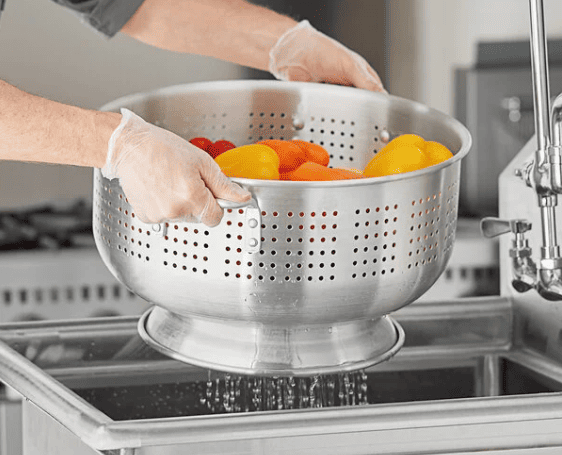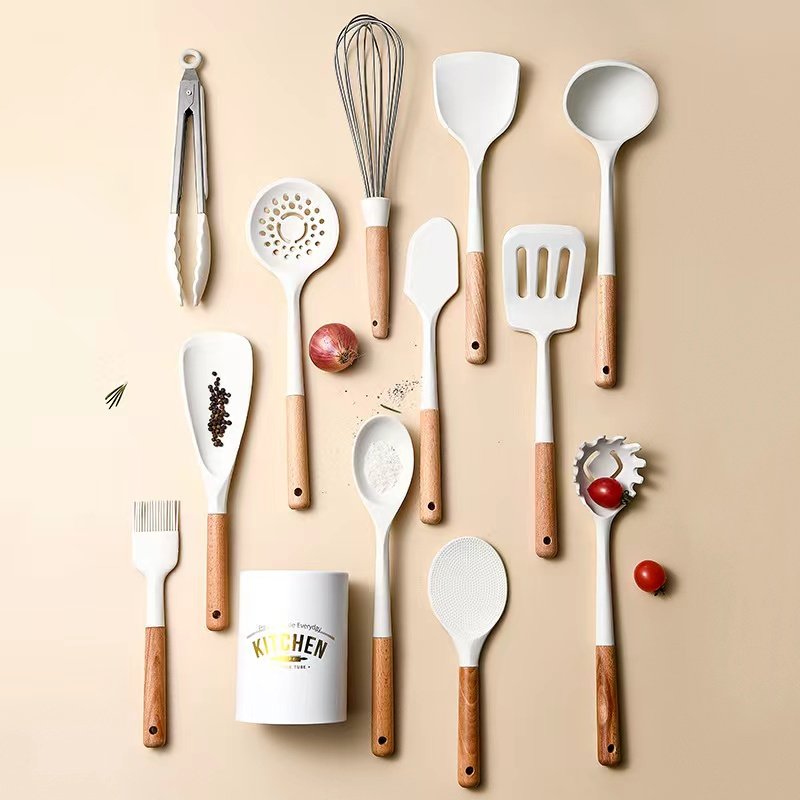In professional kitchens, commercial colanders play a crucial role in food preparation. Without the right tools, kitchens can experience reduced efficiency and compromised food quality. Choosing the right commercial colander boosts kitchen productivity and ensures better hygiene.
Commercial colanders are essential in professional kitchens, offering large capacity and durability for high-volume tasks. Using the right colander can improve efficiency, food safety, and hygiene.
Let’s dive deeper into the various types of commercial colanders and explore why selecting the right one matters in a professional setting.
Table of Contents

What Are Commercial Colanders and How Are They Different from Regular Colanders?
Commercial colanders are designed for high-capacity and high-frequency use. Unlike regular colanders, they are built to withstand the demands of a professional kitchen, offering larger sizes, more durable materials, and enhanced functionality.
Commercial colanders are typically larger and more durable than home-use versions. They come in various materials like stainless steel and plastic, designed for extensive use in restaurants and catering businesses.
Commercial colanders are crafted to meet the needs of professional kitchens, where the volume of food preparation is significantly higher. The larger capacity of these colanders allows chefs to drain large batches of pasta, vegetables, or fruits quickly. The materials also differ—while home colanders might be made from lightweight plastic, commercial models are often made from stainless steel for its durability, resistance to corrosion, and ease of cleaning.
- Material Considerations:
Stainless steel is the preferred choice for commercial colanders due to its strength and resistance to rust. Plastic colanders, while lighter, are not as durable and may warp under high heat. Depending on the kitchen’s needs, some chefs opt for Large commercial stainless steel colanders to ensure longevity and hygiene. - Capacity:
Commercial colanders typically come in extra-large sizes, such as the Extra large colander with handle or the Large catering colander, allowing for bulk food preparation. These colanders ensure that chefs can work efficiently and meet the demands of busy kitchens.
Why Are Quality Materials Important for Commercial Colanders?
The choice of material for a commercial colander significantly impacts its performance, durability, and ease of maintenance, all of which are essential in a fast-paced kitchen environment.
Materials like stainless steel and aluminum provide strength and longevity, while plastic models are lighter but may not withstand the high demands of commercial kitchens.
The material of a commercial colander influences its heat resistance, weight, and cleaning ease. Stainless steel colanders are favored for their ability to resist rust and staining, making them ideal for kitchens where hygiene is paramount. On the other hand, plastic colanders are often lighter and more affordable, but they may not endure high temperatures or heavy use. For professional kitchens where colanders are used frequently, investing in a Large commercial stainless steel colander can lead to greater long-term savings due to its durability.
- Durability:
Stainless steel is durable and won’t warp or discolor after long-term use. It’s also resistant to acids in foods like tomatoes and vinegar, which can damage lower-quality materials. - Ease of Cleaning:
Stainless steel colanders are dishwasher-safe, while plastic options may discolor or retain odors over time, making them less hygienic. A commercial strainer with handle made from stainless steel is also easier to maneuver and clean.
How Can Commercial Colanders Improve Kitchen Efficiency and Hygiene?
In professional kitchens, the right colander not only speeds up food preparation but also ensures that food is properly drained, preventing cross-contamination.
By using commercial colanders designed for large volumes, kitchens can maintain cleanliness and efficiency. Regular cleaning helps prevent bacteria build-up, which is crucial in food handling.
The use of commercial colanders contributes directly to kitchen hygiene and efficiency. These tools are typically designed with larger holes and better drainage, allowing water to flow out quickly, preventing food from becoming soggy. A Large catering colander, for example, allows chefs to drain a large batch of vegetables or pasta in seconds, improving the overall flow of kitchen operations.
- Food Safety:
Colanders made from stainless steel or other non-porous materials reduce the risk of bacteria buildup compared to cheaper plastic models. By opting for a Stainless steel colander with handle, chefs can handle hot ingredients safely while keeping their tools sanitary. - Faster Workflow:
A well-chosen commercial colander can save chefs time during meal prep. A Large commercial colander allows for quicker preparation of multiple dishes at once, helping kitchens meet tight deadlines and serve food faster.
What Is a Chinese Colander and How Is It Different?
A Chinese colander, often referred to as a “Chinese strainer” or “Chinese mesh strainer,” is an essential tool in Asian cooking, typically used for deep frying, steaming, and draining food.
Chinese colanders are usually designed with deep baskets and fine mesh, perfect for draining liquids or steaming delicate foods like dumplings. Unlike Western colanders, they’re typically round and feature a handle for better control.
A Chinese strainer (also known as a Chinese colander) differs significantly from Western colanders. Its mesh is usually finer, designed to handle small particles such as seeds or flour without letting them pass through. Often made from bamboo or stainless steel, these strainers are ideal for steaming dim sum or filtering broths. A Chinese mesh strainer is more delicate and features a shallow, wide design compared to the deeper, more durable colanders used in Western kitchens.
- Design:
The round shape and shallow depth of a Chinese strainer make it perfect for tasks like lifting dumplings from hot water or draining excess oil from deep-fried items. These strainers provide excellent precision, which is essential in delicate Asian cooking techniques.
What Is the Difference Between a Colander and a Strainer?
The terms “colander” and “strainer” are often used interchangeably, but they serve different purposes in food preparation.
While a colander is designed for draining larger amounts of liquid, a strainer is used for fine filtering, typically for small particles or liquids like broths.
The key difference between a colander and a strainer lies in their design and functionality. A colander has larger holes designed to drain larger quantities of food quickly, like pasta or vegetables. A strainer has much finer mesh designed to catch smaller particles such as for straining broth or sifting flour. For most professional kitchens, both tools are essential. A Commercial strainer with handle allows chefs to quickly pour liquids while preventing clogs; meanwhile, a colander can handle larger volumes of food at once.
- Usage in Kitchen:
Colanders are primarily used for larger food items like pasta or vegetables while strainers are for fine filtration tasks such as separating tea leaves or straining sauces.
Are Metal or Plastic Colanders Better?
Both metal and plastic colanders have their advantages; however, which one is better for your kitchen depends on the tasks at hand.
Metal colanders—especially those made from stainless steel—are more durable and heat-resistant while plastic colanders are lighter and more affordable.
Metal colanders—particularly stainless steel colanders with handles—offer superior durability, making them the preferred choice for high-use commercial kitchens. They resist heat and are easy to clean; whereas plastic colanders tend to warp and discolor over time. A Large commercial stainless steel colander is ideal for tasks that involve heat like draining boiling pasta or vegetables. Plastic models such as the Extra large plastic colander, on the other hand, are better suited for lighter tasks like rinsing fruits.
- Long-Term Durability:
While plastic colanders may be suitable for occasional use**, metal colanders will last longer under heavy-duty use**, making them a better investment for professional kitchens.
What Are 3 Things a Colander Is Used For?
Colanders are versatile tools in any kitchen. Here are three common ways they are used in food preparation.
Colanders are typically used for draining pasta, washing vegetables, and straining liquids. Their versatility makes them essential tools in many kitchens.
- Draining Pasta:
A large commercial colander is perfect for draining large quantities of pasta quickly. The wide holes and large size ensure that water drains efficiently without damaging the noodles. - Washing Vegetables:
A colander is ideal for rinsing vegetables like leafy greens or fruits ensuring that dirt and pesticides are washed away. - Straining Liquids:
Colanders can also be used for straining broths sauces or oils providing an efficient way to remove solid particles from liquids.
In conclusion, commercial colanders are indispensable in professional kitchens. Their durability material quality and size can make all the difference in improving kitchen efficiency food safety and hygiene. Whether you’re choosing a large commercial stainless steel colander or a plastic colander, selecting the right tool for your needs ensures smoother kitchen operations.








